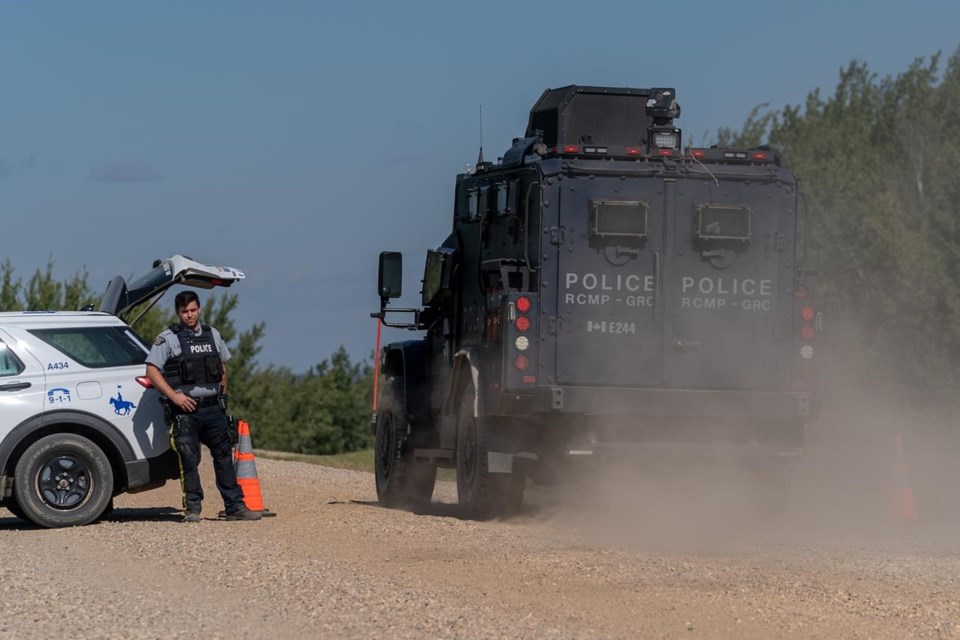MELFORT, Sask. — Some family members say they don't have faith in a coroner's inquest as Mounties who responded to a stabbing rampage on a Saskatchewan First Nation testified they found people bleeding and others dead.
"The justice system has never, ever been kind to us native people," said Darryl Burns, whose sister, Gloria Burns, was among those killed during a massacre on the James Smith Cree Nation on Sept. 4, 2022.
"So do we have faith in this justice system? Do we have faith in this (inquest)? I don't think we do."
The inquest heard Wednesday from two RCMP officers who responded to initial 911 calls from residents saying Myles Sanderson had stormed into their homes.
Sanderson killed 11 people on the First Nation and in the nearby village of Weldon. Seventeen others were injured.
The 32-year-old died in police custody a few days later.
Const. Tanner Maynard said RCMP had already received four complaints about stabbings when he responded to the first home on the First Nation.
Maynard saw the body of Robert Sanderson, who was already dead, lying outside the home. Const. David Miller, the officer's partner, went to check on Brandon Genereaux, Robert Sanderson's son.
"He was covered in blood," Maynard said of Genereaux.
Maynard described the dead and injured he saw as he went to different houses on the First Nation northeast of Saskatoon.
The inquest is to establish the events leading up to the killings, who died, and when and where each person was killed.It has been scheduled for at least two weeks.
A second inquest focusing on the killer's death is scheduled for February.
Maynard became emotional as he spoke of how he found Carol Burns dead inside another home. The officer also saw the woman's son, Thomas Burns, who had been killed outside.
Family members cried and held each other as Maynard described the horrific scenes left behind by the killer.
Deborah Burns, speaking on behalf of the family of Earl Burns Sr., the killer's former father-in-law who died in the attacks, asked the officer if he performed life-saving measures on any of the victims.
Maynard said he directed people to put pressure on wounds but the officer said many calls had come in and a killer was on the loose. It's hard not to be able to help each person, Maynard said, taking a moment to collect himself. "My ultimate goal was to take Myles Sanderson into custody."
The inquest has heard how Myles Sanderson and his brother, Damien Sanderson, caused chaos in the community in the days before the attacks.
Staff Sgt. Robin Zentner, with the RCMP major crimes unit, testified earlier this week Mounties had uncovered texts between the brothers and some victims that mentioned drug sales and debts.
But Zentner said there's no indication the killings were gang-related. Some were clearly random.
Damien Sanderson was the first person killed. Myles Sanderson then went from home to home, armed with a knife, kicking in doors and stabbing people.
RCMP have said because the killer is dead, people may never get all the answers about what happened.
Earlier Wednesday, the top Mountie at the Melfort detachment testified officers have a lot on their plates.
"Our officers are being pressed," said Staff Sgt. Ryan Case.
Case was not in charge of or working at the detachment on the day of the attacks.
He told the inquest the detachment has 16 officers, including 13 constables, who work on the front lines, and serves a population of about 15,000.
The detachment is staffed 20 hours a day and officers are on call from 4 a.m. to 8 a.m.
Case said the detachment works with other RCMP units, including on drug investigations. Officers monitor warrants and are involved in some cases when people are unlawfully at large, he said, but the RCMP in Saskatchewan also have a separate warrant suppression team.
The inquest heard many questions about how Mounties respond to outstanding warrants. There were warrants for both brothers at the time of the rampage.
Maynard and Miller testified the officers were called to the First Nation the day before the massacre after Damien Sanderson's wife called 911. She said he had taken her vehicle without permission and there were outstanding warrants in relation to domestic violence charges.
The officers located the vehicle and went into a house asking for Damien Sanderson. Maynard told the inquest he later learned he spoke to Damien in the home but was given a false name.
The photo police had was from 2014 and Maynard didn't recognize him.
Myles Sanderson, who had a record of violent assaults, received statutory release earlier in 2022, but was unlawfully at large at the time of the killings.
"It seems like Myles wasn't very high priority for anyone to apprehend," Darryl Burns said during the inquest.
Keith Brown, the lawyer representing the First Nation, asked Case how Mounties notify communities about warrants or people who are unlawfully at large.
"It's not a routine thing," Case said.
The officer also described having a good relationship with the First Nation's security team, which was created after the killings. Case said the RCMP is working to strengthen communication and establish regular meetings with the security team.
Stewart Head, whose family members were killed, was a security supervisor in the community until he was injured at work recently. He said it has been challenging to keep the community safe.
"We are overwhelmed," he said.
This report by The Canadian Press was first published Jan. 17, 2024.
Kelly Geraldine Malone, The Canadian Press



